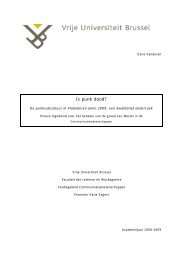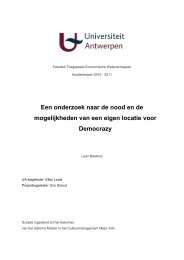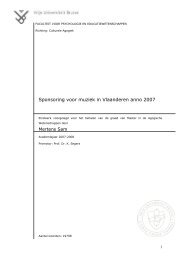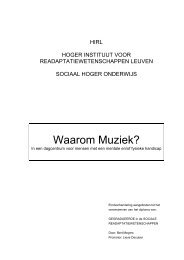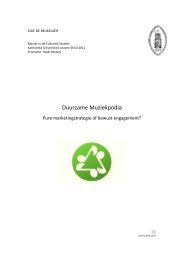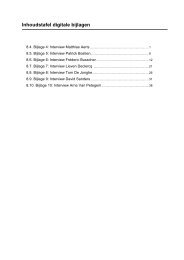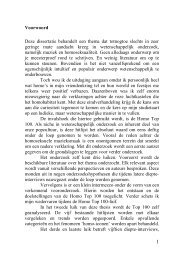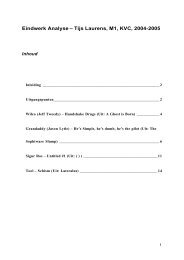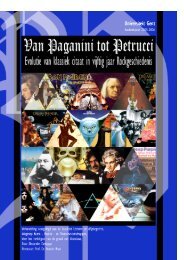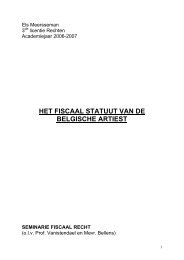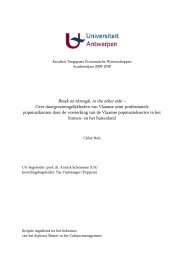Hip hop identity in a township reality. - Poppunt
Hip hop identity in a township reality. - Poppunt
Hip hop identity in a township reality. - Poppunt
You also want an ePaper? Increase the reach of your titles
YUMPU automatically turns print PDFs into web optimized ePapers that Google loves.
where the many <strong>township</strong>s arose. The report argued <strong>in</strong> favour of a solution that<br />
allowed for the differences between the population groups without neglect<strong>in</strong>g their<br />
economical entw<strong>in</strong>ement (Vervliet: 35). In other words, the report recommended a<br />
gradual end to segregation <strong>in</strong> the cities, which would also mean the system of<br />
labour migration would not be necessary anymore whereby the black population<br />
was settled <strong>in</strong> distant rural areas (Wikipedia).<br />
In response to the Fagan Commission, the NP (who took power from the UP later<br />
that year) ordered its own commission (the Sauer Commission) to <strong>in</strong>vestigate the<br />
general policy with regard to the black population (Vervliet: 35). The solution that<br />
was proposed by the Fagan Commission was not feasible accord<strong>in</strong>g to the Sauer<br />
Commission. Instead, a system of complete partition was proposed. Different racial<br />
groups would be completely separated from each other. The system of apartheid<br />
was born as an ideology of fear from a m<strong>in</strong>ority to become overrun by the majority.<br />
The <strong>in</strong>tegration of black people <strong>in</strong> the predom<strong>in</strong>antly white cities would equal the<br />
loss of <strong>identity</strong> for the whites. Apartheid was associated with the preservation of the<br />
Afrikaner culture (Vervliet: 36). Every person was classified depend<strong>in</strong>g on his or her<br />
race. There were three options: either somebody was white, coloured or black. A<br />
fourth category – Asian/Indian – was later added. For questionable cases there was<br />
a classification board who had to decide which category was most applicable<br />
(Wikipedia). Members of the same family could f<strong>in</strong>d themselves categorised <strong>in</strong><br />
different race groups.<br />
In 1950 the Group Areas Act was <strong>in</strong>troduced <strong>in</strong> an attempt to geographically<br />
separate the different racial groups (Wikipedia). The exist<strong>in</strong>g pass laws became even<br />
more severe from 1952 on (Ross: 146). Blacks and coloureds were compelled to<br />
carry <strong>identity</strong> documents and were kept away from white areas. They could only<br />
enter with a pass, which was only given to people with an approved job (Wikipedia).<br />
In daily life, apartheid led to the segregation on public transport, beaches,<br />
swimm<strong>in</strong>g pools, libraries, restaurants and so on (Vervliet: 17-18). Apartheid<br />
pervaded South African culture as well as the law. The media re<strong>in</strong>forced the<br />
perception of non-white South Africans as second-class citizens (Wikipedia).<br />
In 1955 the Toml<strong>in</strong>son Commission proposed a plan to give black people their own<br />
separate states that were go<strong>in</strong>g to be politically <strong>in</strong>dependent from South Africa<br />
(Wikipedia). The black population was divided accord<strong>in</strong>g to their mother language,<br />
descent and cultural habits (Vervliet: 18). They would become citizens of the<br />
‘homelands’ or ‘bantustans’ they were sent to. The South African government<br />
attempted to divide the country <strong>in</strong>to a number of separate states. More than eighty



